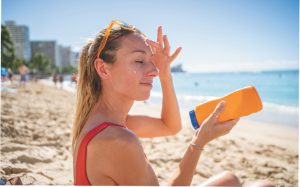By Dr. Andrew Kontos
 With summer approaching and UV Safety Month in full swing, it’s a great time to talk about sunscreen and its importance in protecting our skin from the harmful effects of ultraviolet radiation. Sunscreen is a crucial line of defense against sunburns, premature aging, and skin cancer, but it’s essential to understand how it works and what ingredients to look for to ensure maximum protection.
With summer approaching and UV Safety Month in full swing, it’s a great time to talk about sunscreen and its importance in protecting our skin from the harmful effects of ultraviolet radiation. Sunscreen is a crucial line of defense against sunburns, premature aging, and skin cancer, but it’s essential to understand how it works and what ingredients to look for to ensure maximum protection.
What Does Sunscreen Really Do?
Sunscreen is designed to absorb or reflect ultraviolet (UV) radiation from the sun, preventing it from penetrating the skin and causing damage. There are two main types of UV radiation that sunscreens protect against: UVA and UVB.
UVB rays are responsible for causing sunburns and playing a significant role in the development of skin cancers. These rays have a shorter wavelength and are partially absorbed by the ozone layer, but they are still capable of causing harm.
UVA rays, on the other hand, have a longer wavelength and can penetrate deeper into the skin, contributing to premature aging, wrinkles, and potentially increasing the risk of skin cancer. They are not filtered by the ozone layer and are present year-round, even on cloudy days.
Sunscreens work by using active ingredients that either absorb or reflect these harmful UV rays, preventing them from reaching the sensitive skin cells below the surface.
Ingredients to Look For
When shopping for sunscreen, it’s essential to look for products that offer broad-spectrum protection, meaning they block both UVA and UVB rays. Here are some common active ingredients to look for:
1. Mineral sunscreens (physical blockers):
– Zinc oxide
– Titanium dioxide
These ingredients work by reflecting and scattering UV rays away from the skin, providing a physical barrier against both UVA and UVB radiation.
2. Chemical sunscreens (organic filters):
– Avobenzone
– Oxybenzone
– Octocrylene
– Ecamsule
These ingredients absorb UV radiation, converting it into a small amount of heat that is then released from the skin.
It’s important to note that some chemical sunscreens, like oxybenzone, have been a subject of controversy due to potential health and environmental concerns. Many experts recommend opting for mineral sunscreens or newer chemical filters like Ecamsule, which are generally considered safer alternatives.
Other Considerations
In addition to the active ingredients, there are a few other factors to keep in mind when choosing a sunscreen:
. SPF (Sun Protection Factor): Look for a sunscreen with an SPF of 30 or higher, which blocks approximately 97% of UVB rays.
. Water resistance: If you plan to swim or engage in activities that will cause sweating, choose a water-resistant sunscreen.
. Expiration date: Sunscreens can lose their effectiveness over time, so check the expiration date and replace expired products.
. Broad-spectrum protection: As mentioned earlier, choose a sunscreen that offers protection against both UVA and UVB rays.
Remember, sunscreen is just one part of a comprehensive sun protection strategy. It’s also essential to seek shade, wear protective clothing (including hats and sunglasses), and avoid prolonged exposure to the sun during peak hours when UV radiation is strongest.
By understanding how sunscreen works and choosing the right products with the appropriate ingredients, you can ensure you and your loved ones stay safe and protected from the harmful effects of UV radiation this summer and beyond.
At Soluna Medical Aesthetics, the convergence of medical expertise and spa luxury creates a haven for personalized skincare journeys. Whether you embark on the transformative path of HydraFacial and SkinCeuticals or indulge in the sensory delights of FarmHouseFresh Organic Vegan skincare, rest assured that your skin is in expert hands. With each facial, a symphony of science and serenity unfolds, unveiling the true essence of beauty: confidence, luminosity, and inner harmony.
Dr. Andrew Kontos
Dr. Andrew Kontos is a highly regarded board-certified dermatologist and fellowship-trained and board-certified Mohs micrographic and cutaneous oncology surgeon. Committed to providing high-quality skin care, Dr. Kontos stays current in medical advancements to continue offering the best care available for his patients. Compassion, accountability, respect, and excellence guide his patient-centered model of delivering positive outcomes. Dr. Kontos has been trained in the EuroThread Lift procedure since 2018 and recently received Advanced Threadlifting Certification.
8800 Bernwood Parkway, Unit 2
Bonita Springs. FL 34135
239-317-2940
www.solunamedicalaesthetics.com









